Artificial dataset A
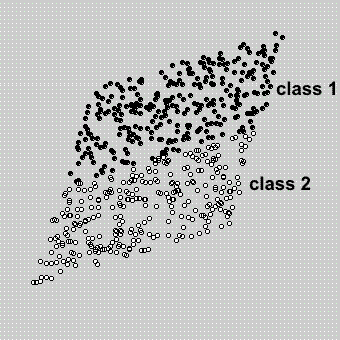
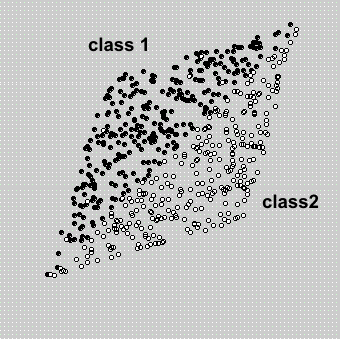
5.1. Artificial datasets without feature selection
|
Artificial dataset A
|
Artificial dataset
B
|
In the next experiments 2 dimensions are used to make both transformations (n_vectors=2;).
As PCA and ICA are non-supervised methods, both artificial datasets (A and B) are equivalent to the feature extraction methods.
EXPERIMENT 1
Artificial dataset A and FASTICA
nc=2; %number of classes
np=300; %number of samples per class
n_vectors=2; %number of vectors used to reduce the data
nr=5; %number of repetitions of the classification process
per_test=0.5; %percentage of test samples from x (0-1)
>> example(1,1,0)

| Classifying...... REPETITION no. 1 FastICA Recognition rate:99.00 Whitening Recognition rate :99.00 REPETITION no. 2 FastICA Recognition rate:98.00 Whitening Recognition rate :98.00 REPETITION no. 3 FastICA Recognition rate:98.00 Whitening Recognition rate :98.00 REPETITION no. 4 FastICA Recognition rate:97.33 Whitening Recognition rate :97.33 REPETITION no. 5 FastICA Recognition rate:98.33 Whitening Recognition rate :98.33 For all the repetitions: FastICA Recognition rate:98.13 ± 0.27 Whitening Recognition rate :98.13 ± 0.27 |
EXPERIMENT 2
Artificial dataset A and INFOMAX
nc=2; %number of classes
np=300; %number of samples per class
n_vectors=2; %number of vectors used to reduce the data
nr=5; %number of repetitions of the classification process
per_test=0.5; %percentage of test samples from x (0-1)
>> example(1,2,0)
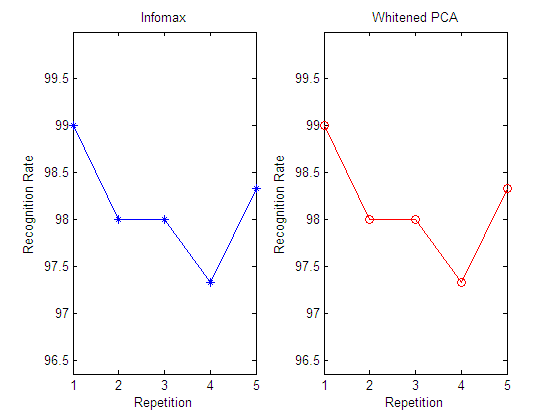
| Classifying...... REPETITION no. 1 Infomax Recognition rate:99.00 Whitening Recognition rate :99.00 REPETITION no. 2 Infomax Recognition rate:98.00 Whitening Recognition rate :98.00 REPETITION no. 3 Infomax Recognition rate:98.00 Whitening Recognition rate :98.00 REPETITION no. 4 Infomax Recognition rate:97.33 Whitening Recognition rate :97.33 REPETITION no. 5 Infomax Recognition rate:98.33 Whitening Recognition rate :98.33 For all the repetitions: Infomax Recognition rate:98.13 ± 0.27 Whitening Recognition rate :98.13 ± 0.27 |
EXPERIMENT 3
Artificial dataset B and FASTICA
nc=2; %number of classes
np=300; %number of samples per class
n_vectors=2; %number of vectors used to reduce the data
nr=5; %number of repetitions of the classification process
per_test=0.5; %percentage of test samples from x (0-1)
>> example(2,1,0)
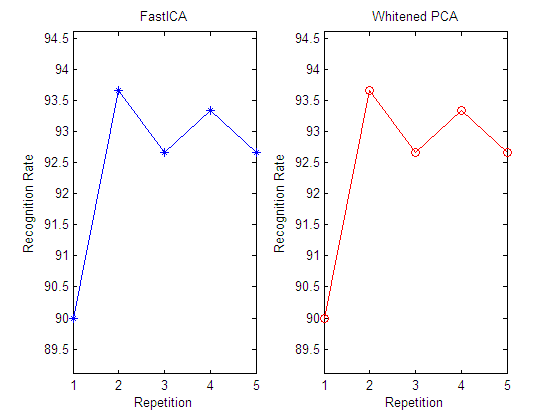
| Classifying...... REPETITION no. 1 FastICA Recognition rate:90.00 Whitening Recognition rate :90.00 REPETITION no. 2 FastICA Recognition rate:93.67 Whitening Recognition rate :93.67 REPETITION no. 3 FastICA Recognition rate:92.67 Whitening Recognition rate :92.67 REPETITION no. 4 FastICA Recognition rate:93.33 Whitening Recognition rate :93.33 REPETITION no. 5 FastICA Recognition rate:92.67 Whitening Recognition rate :92.67 For all the repetitions: FastICA Recognition rate:92.47 ± 0.65 Whitening Recognition rate :92.47 ± 0.65 |
EXPERIMENT 4
Artificial dataset B and INFOMAX
nc=2; %number of classes
np=300; %number of samples per class
n_vectors=2; %number of vectors used to reduce the data
nr=5; %number of repetitions of the classification process
per_test=0.5; %percentage of test samples from x (0-1)
>> example(2,2,0)
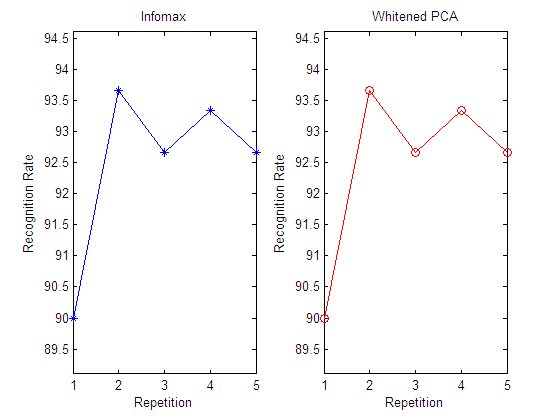
| Classifying...... REPETITION no. 1 Infomax Recognition rate:90.00 Whitening Recognition rate :90.00 REPETITION no. 2 Infomax Recognition rate:93.67 Whitening Recognition rate :93.67 REPETITION no. 3 Infomax Recognition rate:92.67 Whitening Recognition rate :92.67 REPETITION no. 4 Infomax Recognition rate:93.33 Whitening Recognition rate :93.33 REPETITION no. 5 Infomax Recognition rate:92.67 Whitening Recognition rate :92.67 For all the repetitions: Infomax Recognition rate:92.47 ± 0.65 Whitening Recognition rate :92.47 ± 0.65 |
CONCLUSIONS (Experiments 1-4)
In the code used for these experiments, feature extraction process is performed just once, using all the available examples in each class. Then, 5 repetitions run the classifier with randomly selected train and test sets. In this example 50% of the data is use to train the 1-NN and the other 50% is used to test (per_test=0.5;).
From the results in the above experiments it is easy to see the equivalence between the whitened and the ica data.
The recognition rate for these datasets is equal for both algorithms in each experiment. However, in the next experiments with real data (object images and faces), we will only get approximate equivalence: FastICA gives the same classification performance as whitened data, but Infomax will give results which are significantly different, but the difference is typically relatively small.